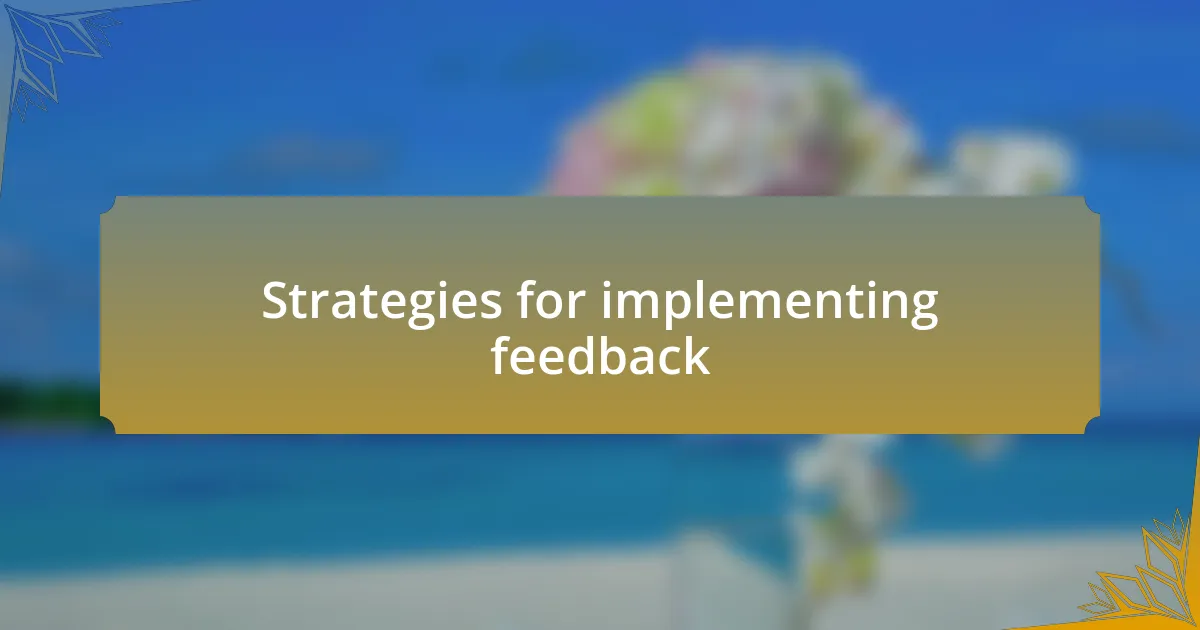Key takeaways:
- Continuous feedback fosters deeper customer relationships, enhances satisfaction, and promotes loyalty through open dialogue and collaboration.
- Timely and actionable feedback can lead to significant improvements and innovations in products and services, creating a culture of continuous improvement.
- Utilizing various feedback collection tools, such as online surveys and live chats, helps uncover valuable insights and enhances customer engagement.
- Case studies highlight the effectiveness of integrating customer feedback into processes, leading to meaningful changes and innovations in businesses.

Understanding continuous feedback
Continuous feedback is all about maintaining an ongoing dialogue with customers, allowing their insights to shape the evolution of a product or service. I remember a time when I decided to implement regular surveys after some major releases. The feedback didn’t just highlight the bugs we overlooked; it opened my eyes to features that our users truly valued. This kind of engagement feels less like a transaction and more like a partnership, doesn’t it?
When we embrace continuous feedback, we create a culture of openness where every voice matters. I often think of feedback as a gift; even when it’s hard to hear, it’s an invaluable opportunity for growth. Each comment or suggestion is a stepping stone toward creating a better experience for everyone involved, and that’s something I’ve witnessed firsthand. Have you ever considered how a single piece of feedback transformed your perspective on a product?
Moreover, the power of continuous feedback lies in its immediacy. In my experience, timely responses to customer insights lead to quick adaptations, which can significantly enhance customer loyalty. I still recall the excitement when a simple tweak based on user input led to a noticeable increase in satisfaction scores. It’s a reminder that listening closely can lead to remarkable changes that customers deeply appreciate.

Importance of continuous feedback
Continuous feedback is essential because it fosters deeper relationships with customers. I once ran a focus group where we discussed a feature that had been poorly received. The candidness in their feedback was eye-opening; it made me realize that understanding their emotions and priorities was just as important as functionality. Have you ever found that a problem you thought was minimal actually mattered much more to your users?
Incorporating ongoing feedback also drives innovation. A project I was involved in saw a dramatic shift in direction based entirely on user suggestions. This wasn’t just about fixing issues; it was about adding value in ways we hadn’t imagined. I’ve learned that when customers feel heard, they often become advocates for your brand. Isn’t it fascinating how collaboration can spark creativity that leads to groundbreaking ideas?
The significance of continuous feedback is also evident in enhancing customer satisfaction. One time, a single piece of feedback highlighted a frustrating part of the user journey. Taking action not only resolved that concern but also significantly uplifted the overall user experience. I often reflect on how a simple act of listening can lead to profound improvements. Isn’t that the kind of transformation we all aim for?

Benefits for customer experience
Continuous feedback can significantly enhance customer experience by allowing businesses to adapt swiftly to changing needs. I remember a time when a customer suggested a simple tweak to our service offering, which resulted in higher satisfaction rates. Have you ever thought about how a small adjustment might turn frustration into delight for your customers?
Moreover, engaging customers through ongoing feedback creates a sense of ownership and loyalty. I’ve noticed that when customers feel their opinions matter, they’re more willing to stick around and invest in the brand. Isn’t it interesting how a few thoughtful conversations can transform a transactional relationship into a lasting partnership?
Additionally, consistent feedback helps in identifying gaps in the customer journey. During one project, I realized we were missing key insights by not actively soliciting input from our users. Acting on that feedback led to substantial improvements, and it hit me how crucial it is to keep the lines of communication open. How often do we overlook the voice of the customer in shaping our strategies?

Strategies for implementing feedback
When implementing feedback, it’s essential to create a structured process that encourages open dialogue. I recall a time when we established regular feedback sessions with our clients, which not only provided valuable insights but also fostered a culture of transparency. Isn’t it refreshing to have a platform where ideas and concerns can be shared openly?
Another effective strategy involves training your team to actively seek and respond to feedback. In my experience, when employees understand the impact of their interactions, they become more invested in gathering insights. Have you seen how a simple shift in mindset can transform customer encounters from routine transactions into meaningful exchanges?
Moreover, leveraging technology can streamline the feedback collection process. We integrated a user-friendly feedback tool that allowed customers to share their thoughts easily, and the response rate skyrocketed. It made me realize how vital it is to remove barriers for customers to voice their opinions—what tools have you found effective in your own feedback journey?

Tools for collecting feedback
When I think about tools for collecting feedback, I can’t help but appreciate the power of online surveys. We once rolled out a quick survey after a major product launch and were amazed at how quickly customers shared their thoughts. It’s a straightforward yet impactful way for clients to express their feelings—don’t you find it fascinating how a simple question can unveil a wealth of insights?
Another tool that has transformed our approach to feedback is live chat features on our website. I remember a customer reaching out with a question, and it turned into a detailed discussion about their experience. That real-time interaction not only provided immediate insights but also made the customer feel heard and valued. I wonder, how often do you think a conversation can lead to unexpected feedback gems?
Lastly, I’ve seen great success using social media for feedback collection. By monitoring comments and messages, I’ve gathered nuanced perceptions that traditional methods often miss. A casual tweet can reveal sentiment and preferences in ways structured surveys sometimes can’t. Have you ever been surprised by what you learn just by listening to conversations happening around your brand?

My personal feedback approach
When it comes to my personal feedback approach, I prioritize creating an environment where customers feel comfortable sharing their thoughts openly. In one instance, I hosted a focus group and was genuinely moved by how candid participants were about their experiences. It made me realize that when people feel safe, they don’t just share positive feedback; they voice concerns and suggestions that can lead to significant improvements. How often do we overlook the value in honest, unfiltered opinions?
I also believe in following up with customers after they provide feedback. Recently, I reached out to a client who had expressed dissatisfaction with our service. I asked probing questions to understand the root of their issue, and our conversation unearthed not only their specific frustrations but also opportunities for us to refine our processes. It was enlightening to see how a simple follow-up transformed a negative experience into a constructive dialogue. Have you ever thought about how a conversation can turn a potential loss into a loyal advocate?
Finally, I integrate feedback into every part of my workflow. For instance, after analyzing survey results, I make it a point to share actionable takeaways with my team, shaping our strategy moving forward. This approach fosters a culture of continuous improvement that keeps everyone aligned on our customer-centric goals. It’s fascinating how consistently applying insights from feedback can elevate not just the customer experience, but also the entire team’s morale. What changes do you think you might implement if you approached feedback this way?

Case studies and examples
When I think about the effectiveness of continuous feedback, I recall a major retail brand that implemented an instant feedback tool in their stores. They encouraged customers to rate their shopping experience right after checkout. The result? They noticed a 15% decrease in negative reviews within just a quarter. It’s a vivid reminder of how timely feedback can lead to quick adaptations. Have you ever experienced a service change that seemed to arise out of nowhere, only to realize it was a direct response to customers just like you?
Another example that stands out is a technology company that integrated user feedback directly into their product development cycle. By inviting customers to beta-test new features and provide real-time insights, they uncovered usability issues that internal teams overlooked. This collaboration not only improved the product but also made users feel invested in the brand. Isn’t it incredible how making customers active participants can lead to innovation while forging deeper relationships?
Lastly, I’ve found inspiration in a café that placed comment cards on each table, fostering a dialogue between patrons and staff. The owner shared stories of how specific feedback led to menu changes and improved service practices. One customer’s suggestion for a gluten-free option prompted a full menu revamp that attracted a new clientele. It’s moments like these that illustrate the transformative power of listening. How do you think feedback could innovate your local favorite spots?